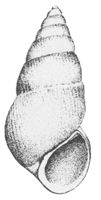The shell illustrated here lacks its operculum.
Genus: PERINGIA Paladilhe, 1874
One species is found in Britain and it is restricted to brackish-water. The British species of Peringia was previously included in Hydrobia. The Clecom List is followed here, as it is in Anderson (2005)

Peringia ulvae
(Pennant, 1777)
Peringia ulvae (Pennant, 1777)
Description: The shell is small with moderately high spire and a brown periostracum. There are 6 or 7 whorls which are nearly flat sided in profile. The aperture is pointed apically. The umbilicus of most shells is a mere chink. The body whorl forms about two-thirds of the height of the shell, and the mouth about 40%. The snout of the animal is long and bifid at the tip, and has a dark transverse line immediately behind the pale tip. There is also a black transverse line on each cephalic tentacle a little behind the tip.
Size: Height : Up to 6 mm. Breadth: 2.5 – 3 mm.
Habitat: Wet banks of sand or mud, preferring estuaries, but occasionally on open coasts. It often occurs in enormous numbers on estuarine mud. It occurs throughout the British Isles in suitable habitats.
